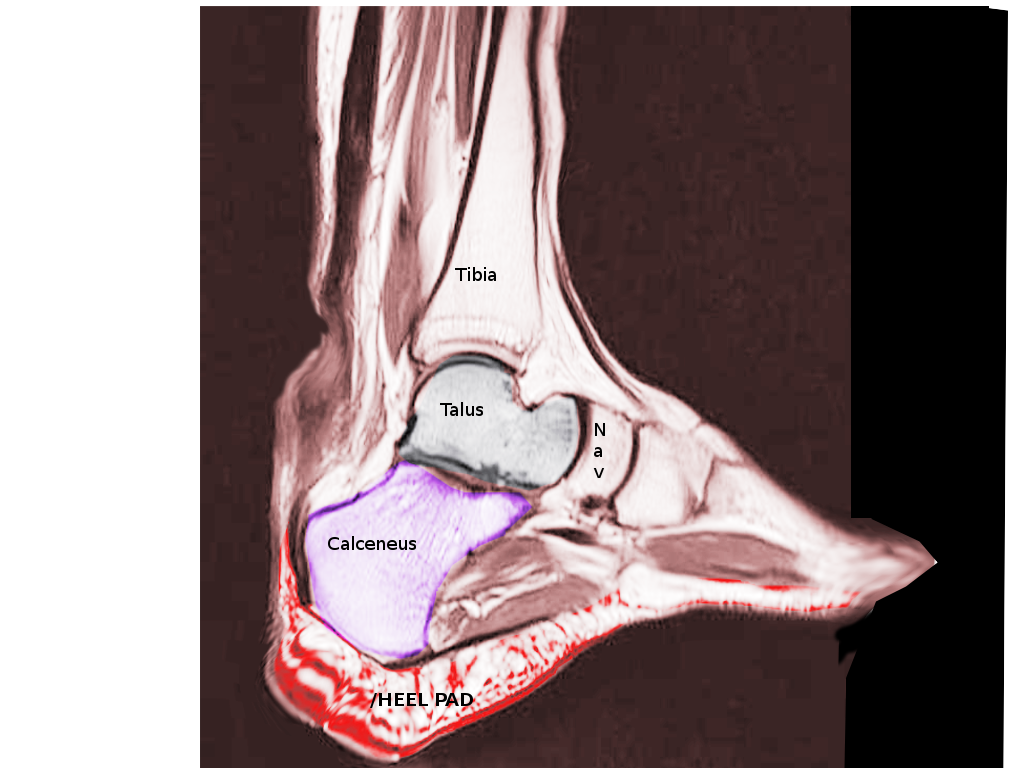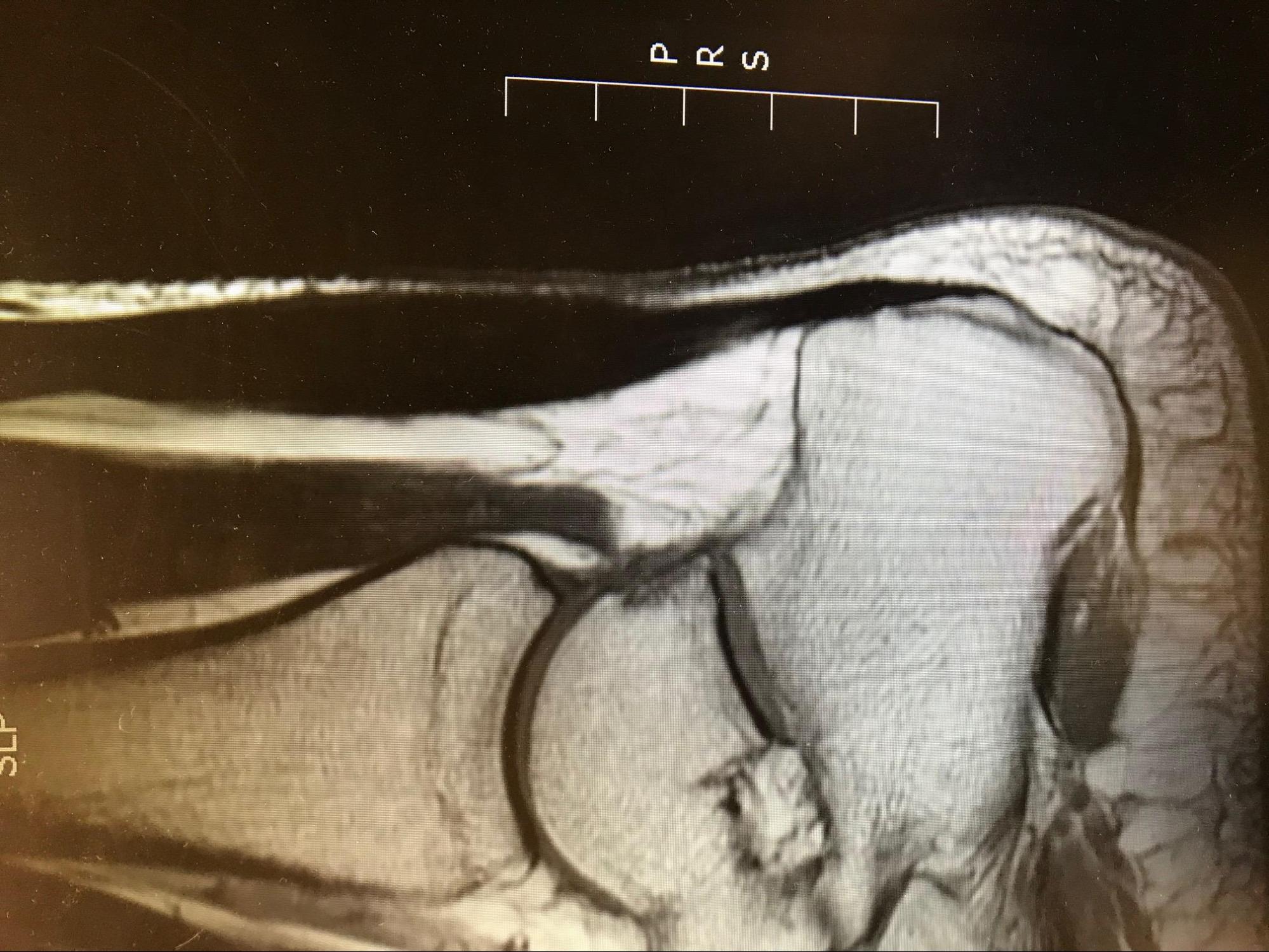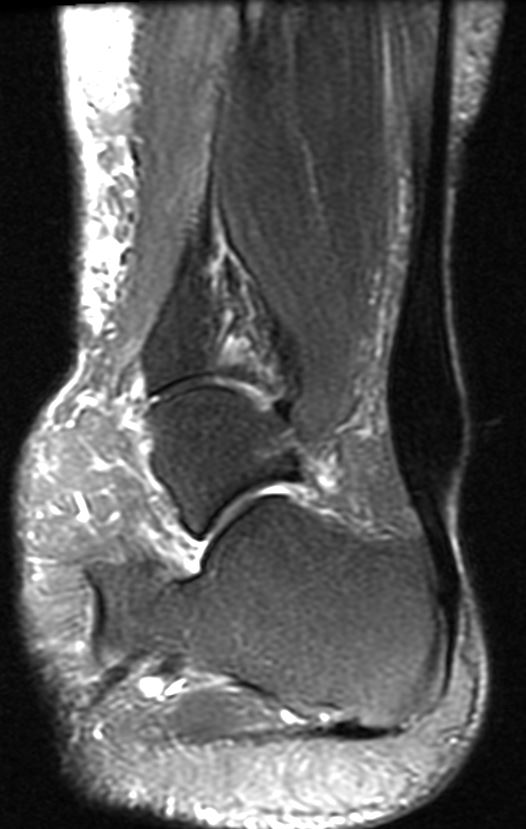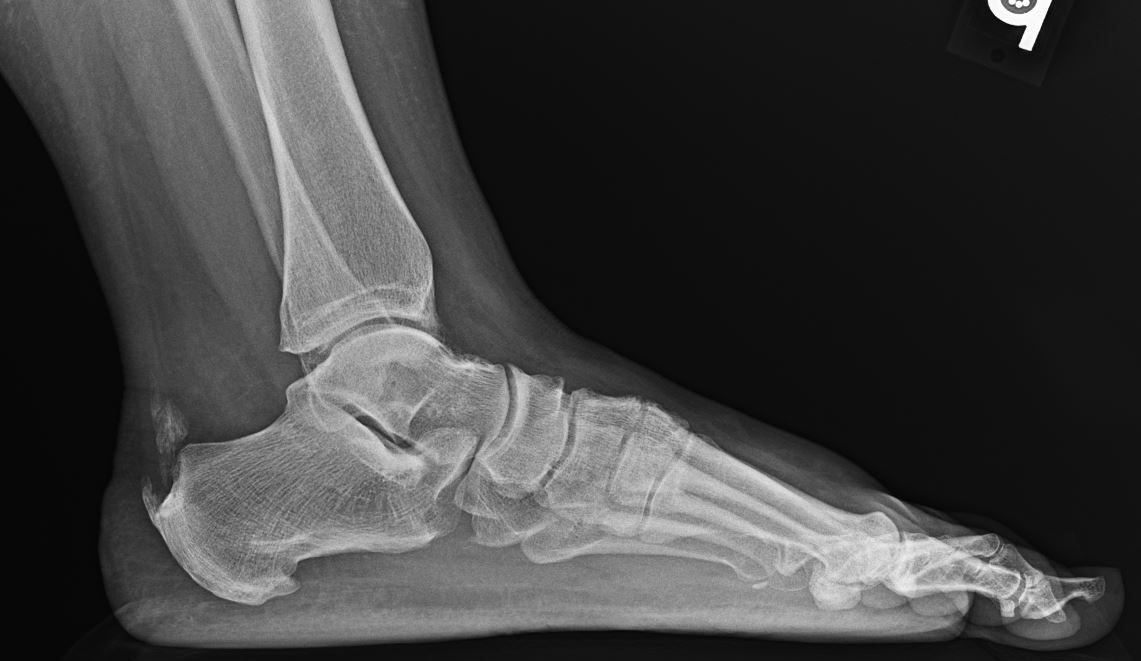[2]
Chimenti RL, Cychosz CC, Hall MM, Phisitkul P. Current Concepts Review Update: Insertional Achilles Tendinopathy. Foot & ankle international. 2017 Oct:38(10):1160-1169. doi: 10.1177/1071100717723127. Epub 2017 Aug 8
[PubMed PMID: 28789557]
[3]
Weinfeld SB. Achilles tendon disorders. The Medical clinics of North America. 2014 Mar:98(2):331-8. doi: 10.1016/j.mcna.2013.11.005. Epub
[PubMed PMID: 24559878]
[4]
Ahmed IM, Lagopoulos M, McConnell P, Soames RW, Sefton GK. Blood supply of the Achilles tendon. Journal of orthopaedic research : official publication of the Orthopaedic Research Society. 1998 Sep:16(5):591-6
[PubMed PMID: 9820283]
[5]
Mahan J, Damodar D, Trapana E, Barnhill S, Nuno AU, Smyth NA, Aiyer A, Jose J. Achilles tendon complex: The anatomy of its insertional footprint on the calcaneus and clinical implications. Journal of orthopaedics. 2020 Jan-Feb:17():221-227. doi: 10.1016/j.jor.2019.06.008. Epub 2019 Jun 10
[PubMed PMID: 31889745]
[6]
Rabusin CL, Menz HB, McClelland JA, Evans AM, Malliaras P, Docking SI, Landorf KB, Gerrard JM, Munteanu SE. Efficacy of heel lifts versus calf muscle eccentric exercise for mid-portion Achilles tendinopathy (HEALTHY): a randomised trial. British journal of sports medicine. 2021 May:55(9):486-492. doi: 10.1136/bjsports-2019-101776. Epub 2020 Sep 28
[PubMed PMID: 32988930]
Level 1 (high-level) evidence
[7]
Abate M, Salini V. Mid-portion Achilles tendinopathy in runners with metabolic disorders. European journal of orthopaedic surgery & traumatology : orthopedie traumatologie. 2019 Apr:29(3):697-703. doi: 10.1007/s00590-018-2336-2. Epub 2018 Oct 26
[PubMed PMID: 30367279]
[8]
Zhao H, Ren Y, Roth EJ, Harvey RL, Zhang LQ. Concurrent deficits of soleus and gastrocnemius muscle fascicles and Achilles tendon post stroke. Journal of applied physiology (Bethesda, Md. : 1985). 2015 Apr 1:118(7):863-71. doi: 10.1152/japplphysiol.00226.2014. Epub 2015 Feb 5
[PubMed PMID: 25663670]
[9]
Olewnik Ł, Wysiadecki G, Podgórski M, Polguj M, Topol M. The Plantaris Muscle Tendon and Its Relationship with the Achilles Tendinopathy. BioMed research international. 2018:2018():9623579. doi: 10.1155/2018/9623579. Epub 2018 May 31
[PubMed PMID: 29955614]
[10]
Yang X, Coleman DP, Pugh ND, Nokes LD. The volume of the neovascularity and its clinical implications in achilles tendinopathy. Ultrasound in medicine & biology. 2012 Nov:38(11):1887-95. doi: 10.1016/j.ultrasmedbio.2012.07.002. Epub 2012 Sep 10
[PubMed PMID: 22975033]
[11]
Slane LC, Dandois F, Bogaerts S, Vandenneucker H, Scheys L. Non-uniformity in the healthy patellar tendon is greater in males and similar in different age groups. Journal of biomechanics. 2018 Oct 26:80():16-22. doi: 10.1016/j.jbiomech.2018.08.021. Epub 2018 Aug 23
[PubMed PMID: 30224164]
[12]
Pękala PA, Henry BM, Ochała A, Kopacz P, Tatoń G, Młyniec A, Walocha JA, Tomaszewski KA. The twisted structure of the Achilles tendon unraveled: A detailed quantitative and qualitative anatomical investigation. Scandinavian journal of medicine & science in sports. 2017 Dec:27(12):1705-1715. doi: 10.1111/sms.12835. Epub 2017 Jan 30
[PubMed PMID: 28139009]
Level 2 (mid-level) evidence
[13]
Federer AE, Steele JR, Dekker TJ, Liles JL, Adams SB. Tendonitis and Tendinopathy: What Are They and How Do They Evolve? Foot and ankle clinics. 2017 Dec:22(4):665-676. doi: 10.1016/j.fcl.2017.07.002. Epub 2017 Sep 27
[PubMed PMID: 29078821]
[14]
Moon JL, Moon KM, Carlisle DM. Obesity-Related Foot Pain: Diagnosis and Surgical Planning. Clinics in podiatric medicine and surgery. 2019 Jan:36(1):141-151. doi: 10.1016/j.cpm.2018.08.008. Epub 2018 Oct 25
[PubMed PMID: 30446041]
[15]
Bolon B. Mini-Review: Toxic Tendinopathy. Toxicologic pathology. 2017 Oct:45(7):834-837. doi: 10.1177/0192623317711614. Epub 2017 May 28
[PubMed PMID: 28553748]
[17]
Camargo PR, Alburquerque-Sendín F, Salvini TF. Eccentric training as a new approach for rotator cuff tendinopathy: Review and perspectives. World journal of orthopedics. 2014 Nov 18:5(5):634-44. doi: 10.5312/wjo.v5.i5.634. Epub 2014 Nov 18
[PubMed PMID: 25405092]
Level 3 (low-level) evidence
[18]
Godoy-Santos AL, Bruschini H, Cury J, Srougi M, de Cesar-Netto C, Fonseca LF, Maffulli N. Fluoroquinolones and the Risk of Achilles Tendon Disorders: Update on a Neglected Complication. Urology. 2018 Mar:113():20-25. doi: 10.1016/j.urology.2017.10.017. Epub 2017 Oct 23
[PubMed PMID: 29074337]
[19]
Almekinders LC, Engle CR. Common and Uncommon Injuries in Ultra-endurance Sports. Sports medicine and arthroscopy review. 2019 Mar:27(1):25-30. doi: 10.1097/JSA.0000000000000217. Epub
[PubMed PMID: 30601398]
[20]
Brund RBK, Rasmussen S, Kersting UG, Arendt-Nielsen L, Palsson TS. Prediction of running-induced Achilles tendinopathy with pain sensitivity - a 1-year prospective study. Scandinavian journal of pain. 2019 Jan 28:19(1):139-146. doi: 10.1515/sjpain-2018-0084. Epub
[PubMed PMID: 30407913]
[21]
Colbert LH, Hootman JM, Macera CA. Physical activity-related injuries in walkers and runners in the aerobics center longitudinal study. Clinical journal of sport medicine : official journal of the Canadian Academy of Sport Medicine. 2000 Oct:10(4):259-63
[PubMed PMID: 11086751]
[22]
Cassel M, Risch L, Intziegianni K, Mueller J, Stoll J, Brecht P, Mayer F. Incidence of Achilles and Patellar Tendinopathy in Adolescent Elite Athletes. International journal of sports medicine. 2018 Sep:39(9):726-732. doi: 10.1055/a-0633-9098. Epub 2018 Jun 25
[PubMed PMID: 29940667]
[23]
Mulvad B, Nielsen RO, Lind M, Ramskov D. Diagnoses and time to recovery among injured recreational runners in the RUN CLEVER trial. PloS one. 2018:13(10):e0204742. doi: 10.1371/journal.pone.0204742. Epub 2018 Oct 12
[PubMed PMID: 30312310]
[24]
Molyneux P, Carroll M, Stewart S, Brenton-Rule A, Rome K. Ultrasound characteristics of the mid-portion of the Achilles tendon in runners: a systematic review protocol. Systematic reviews. 2017 May 30:6(1):108. doi: 10.1186/s13643-017-0501-z. Epub 2017 May 30
[PubMed PMID: 28558847]
Level 1 (high-level) evidence
[25]
de Jonge S, van den Berg C, de Vos RJ, van der Heide HJ, Weir A, Verhaar JA, Bierma-Zeinstra SM, Tol JL. Incidence of midportion Achilles tendinopathy in the general population. British journal of sports medicine. 2011 Oct:45(13):1026-8. doi: 10.1136/bjsports-2011-090342. Epub
[PubMed PMID: 21926076]
[26]
Weber J, Buchhorn T. [Midportion Achilles tendinopathy]. Der Unfallchirurg. 2017 Dec:120(12):1038-1043. doi: 10.1007/s00113-017-0411-5. Epub
[PubMed PMID: 28921035]
[27]
Wezenbeek E, De Clercq D, Mahieu N, Willems T, Witvrouw E. Activity-Induced Increase in Achilles Tendon Blood Flow Is Age and Sex Dependent. The American journal of sports medicine. 2018 Sep:46(11):2678-2686. doi: 10.1177/0363546518786259. Epub 2018 Aug 1
[PubMed PMID: 30067065]
[28]
Lemme NJ, Li NY, DeFroda SF, Kleiner J, Owens BD. Epidemiology of Achilles Tendon Ruptures in the United States: Athletic and Nonathletic Injuries From 2012 to 2016. Orthopaedic journal of sports medicine. 2018 Nov:6(11):2325967118808238. doi: 10.1177/2325967118808238. Epub 2018 Nov 26
[PubMed PMID: 30505872]
[29]
Li HY, Hua YH. Achilles Tendinopathy: Current Concepts about the Basic Science and Clinical Treatments. BioMed research international. 2016:2016():6492597
[PubMed PMID: 27885357]
[30]
Edama M, Takabayashi T, Yokota H, Hirabayashi R, Sekine C, Maruyama S, Otani H. Classification by degree of twisted structure of the fetal Achilles tendon. Surgical and radiologic anatomy : SRA. 2021 Oct:43(10):1691-1695. doi: 10.1007/s00276-021-02803-9. Epub 2021 Jul 14
[PubMed PMID: 34263342]
[31]
Pirozzi KM. Histophysiology of Fibrocartilage. Clinics in podiatric medicine and surgery. 2022 Jul:39(3):363-370. doi: 10.1016/j.cpm.2022.02.002. Epub 2022 May 21
[PubMed PMID: 35717055]
[32]
Kvist M, Józsa L, Järvinen MJ, Kvist H. Chronic Achilles paratenonitis in athletes: a histological and histochemical study. Pathology. 1987 Jan:19(1):1-11
[PubMed PMID: 3588019]
[33]
Klatte-Schulz F, Minkwitz S, Schmock A, Bormann N, Kurtoglu A, Tsitsilonis S, Manegold S, Wildemann B. Different Achilles Tendon Pathologies Show Distinct Histological and Molecular Characteristics. International journal of molecular sciences. 2018 Jan 30:19(2):. doi: 10.3390/ijms19020404. Epub 2018 Jan 30
[PubMed PMID: 29385715]
[34]
Feilmeier M. Noninsertional Achilles Tendinopathy Pathologic Background and Clinical Examination. Clinics in podiatric medicine and surgery. 2017 Apr:34(2):129-136. doi: 10.1016/j.cpm.2016.10.003. Epub 2016 Dec 24
[PubMed PMID: 28257670]
[35]
DeCarbo WT, Bullock MJ. Midsubstance Tendinopathy, Surgical Management. Clinics in podiatric medicine and surgery. 2017 Apr:34(2):175-193. doi: 10.1016/j.cpm.2016.10.006. Epub 2016 Dec 23
[PubMed PMID: 28257673]
[36]
Jeong C, Kim SE, Shim KS, Kim HJ, Song MH, Park K, Song HR. Exploring the In Vivo Anti-Inflammatory Actions of Simvastatin-Loaded Porous Microspheres on Inflamed Tenocytes in a Collagenase-Induced Animal Model of Achilles Tendinitis. International journal of molecular sciences. 2018 Mar 12:19(3):. doi: 10.3390/ijms19030820. Epub 2018 Mar 12
[PubMed PMID: 29534523]
Level 3 (low-level) evidence
[37]
Dakin SG, Newton J, Martinez FO, Hedley R, Gwilym S, Jones N, Reid HAB, Wood S, Wells G, Appleton L, Wheway K, Watkins B, Carr AJ. Chronic inflammation is a feature of Achilles tendinopathy and rupture. British journal of sports medicine. 2018 Mar:52(6):359-367. doi: 10.1136/bjsports-2017-098161. Epub 2017 Nov 8
[PubMed PMID: 29118051]
[38]
El-Habta R, Chen J, Pingel J, Backman LJ. Tendinosis-like changes in denervated rat Achilles tendon. BMC musculoskeletal disorders. 2018 Nov 30:19(1):426. doi: 10.1186/s12891-018-2353-7. Epub 2018 Nov 30
[PubMed PMID: 30497469]
[39]
Obst SJ, Heales LJ, Schrader BL, Davis SA, Dodd KA, Holzberger CJ, Beavis LB, Barrett RS. Are the Mechanical or Material Properties of the Achilles and Patellar Tendons Altered in Tendinopathy? A Systematic Review with Meta-analysis. Sports medicine (Auckland, N.Z.). 2018 Sep:48(9):2179-2198. doi: 10.1007/s40279-018-0956-7. Epub
[PubMed PMID: 29961208]
Level 1 (high-level) evidence
[41]
Martin RL, Chimenti R, Cuddeford T, Houck J, Matheson JW, McDonough CM, Paulseth S, Wukich DK, Carcia CR. Achilles Pain, Stiffness, and Muscle Power Deficits: Midportion Achilles Tendinopathy Revision 2018. The Journal of orthopaedic and sports physical therapy. 2018 May:48(5):A1-A38. doi: 10.2519/jospt.2018.0302. Epub
[PubMed PMID: 29712543]
[42]
Maffulli N, Kenward MG, Testa V, Capasso G, Regine R, King JB. Clinical diagnosis of Achilles tendinopathy with tendinosis. Clinical journal of sport medicine : official journal of the Canadian Academy of Sport Medicine. 2003 Jan:13(1):11-5
[PubMed PMID: 12544158]
[43]
Vo TP, Ho GWK, Andrea J. Achilles Tendinopathy, A Brief Review and Update of Current Literature. Current sports medicine reports. 2021 Sep 1:20(9):453-461. doi: 10.1249/JSR.0000000000000884. Epub
[PubMed PMID: 34524189]
[44]
Longo UG, Ronga M, Maffulli N. Achilles Tendinopathy. Sports medicine and arthroscopy review. 2018 Mar:26(1):16-30. doi: 10.1097/JSA.0000000000000185. Epub
[PubMed PMID: 29300224]
[45]
Matthews W, Ellis R, Furness J, Hing WA. The clinical diagnosis of Achilles tendinopathy: a scoping review. PeerJ. 2021:9():e12166. doi: 10.7717/peerj.12166. Epub 2021 Sep 28
[PubMed PMID: 34692248]
Level 2 (mid-level) evidence
[46]
Bulstra GH, van Rheenen TA, Scholtes VA. Can We Measure the Heel Bump? Radiographic Evaluation of Haglund's Deformity. The Journal of foot and ankle surgery : official publication of the American College of Foot and Ankle Surgeons. 2015 May-Jun:54(3):338-40. doi: 10.1053/j.jfas.2014.07.006. Epub 2014 Aug 30
[PubMed PMID: 25179453]
[47]
Gladman DD, Abufayyah M, Salonen D, Thavaneswaran A, Chandran V. Radiological characteristics of the calcaneal spurs in psoriatic arthritis. Clinical and experimental rheumatology. 2014 May-Jun:32(3):401-3
[PubMed PMID: 24850064]
[48]
Rachel JN, Williams JB, Sawyer JR, Warner WC, Kelly DM. Is radiographic evaluation necessary in children with a clinical diagnosis of calcaneal apophysitis (sever disease)? Journal of pediatric orthopedics. 2011 Jul-Aug:31(5):548-50. doi: 10.1097/BPO.0b013e318219905c. Epub
[PubMed PMID: 21654464]
[49]
Mahoney JM. Imaging Techniques and Indications. Clinics in podiatric medicine and surgery. 2017 Apr:34(2):115-128. doi: 10.1016/j.cpm.2016.10.014. Epub 2017 Jan 19
[PubMed PMID: 28257669]
[50]
Matthews W, Ellis R, Furness J, Hing W. Classification of Tendon Matrix Change Using Ultrasound Imaging: A Systematic Review and Meta-analysis. Ultrasound in medicine & biology. 2018 Oct:44(10):2059-2080. doi: 10.1016/j.ultrasmedbio.2018.05.022. Epub 2018 Jul 12
[PubMed PMID: 30007477]
Level 1 (high-level) evidence
[51]
Romero-Morales C, Martín-Llantino PJ, Calvo-Lobo C, Palomo-López P, López-López D, Pareja-Galeano H, Rodríguez-Sanz D. Comparison of the sonographic features of the Achilles Tendon complex in patients with and without achilles tendinopathy: A case-control study. Physical therapy in sport : official journal of the Association of Chartered Physiotherapists in Sports Medicine. 2019 Jan:35():122-126. doi: 10.1016/j.ptsp.2018.12.003. Epub 2018 Dec 5
[PubMed PMID: 30543997]
Level 2 (mid-level) evidence
[52]
Indino C, D'Ambrosi R, Usuelli FG. Biologics in the Treatment of Achilles Tendon Pathologies. Foot and ankle clinics. 2019 Sep:24(3):471-493. doi: 10.1016/j.fcl.2019.04.009. Epub 2019 May 21
[PubMed PMID: 31370998]
[53]
Bullock MJ, Mourelatos J, Mar A. Achilles Impingement Tendinopathy on Magnetic Resonance Imaging. The Journal of foot and ankle surgery : official publication of the American College of Foot and Ankle Surgeons. 2017 May-Jun:56(3):555-563. doi: 10.1053/j.jfas.2017.01.024. Epub 2017 Feb 28
[PubMed PMID: 28258946]
[54]
Tuite MJ. MR imaging of the tendons of the foot and ankle. Seminars in musculoskeletal radiology. 2002 Jun:6(2):119-31
[PubMed PMID: 12077701]
[55]
Leslie HD, Edwards WH. Neglected ruptures of the Achilles tendon. Foot and ankle clinics. 2005 Jun:10(2):357-70
[PubMed PMID: 15922924]
[56]
Kamel M, Eid H, Mansour R. Ultrasound detection of heel enthesitis: a comparison with magnetic resonance imaging. The Journal of rheumatology. 2003 Apr:30(4):774-8
[PubMed PMID: 12672198]
[57]
Albano D, Messina C, Usuelli FG, De Girolamo L, Grassi M, Maccario C, Bignotti B, Tagliafico A, Sconfienza LM. Magnetic resonance and ultrasound in achilles tendinopathy: Predictive role and response assessment to platelet-rich plasma and adipose-derived stromal vascular fraction injection. European journal of radiology. 2017 Oct:95():130-135. doi: 10.1016/j.ejrad.2017.08.006. Epub 2017 Aug 9
[PubMed PMID: 28987658]
[58]
Ficek K, Filipek J, Ficek J, Muzalewska M, Humpa F. Calcaneal CT is a useful tool for identifying Achilles tendon disorders: a pilot study. Journal of orthopaedic surgery and research. 2017 Sep 25:12(1):139. doi: 10.1186/s13018-017-0638-4. Epub 2017 Sep 25
[PubMed PMID: 28946912]
Level 3 (low-level) evidence
[59]
Huang YB, Zhao YX, Xiao JJ, Li MW, Zhang R, Li SL. [Comparative analysis of the ankle joints in juvenile male soccer players with imaging]. Zhonghua yi xue za zhi. 2016 Jul 5:96(25):1971-5. doi: 10.3760/cma.j.issn.0376-2491.2016.25.003. Epub
[PubMed PMID: 27470952]
Level 2 (mid-level) evidence
[60]
Lang TR, Cook J, Rio E, Gaida JE. What tendon pathology is seen on imaging in people who have taken fluoroquinolones? A systematic review. Fundamental & clinical pharmacology. 2017 Feb:31(1):4-16. doi: 10.1111/fcp.12228. Epub 2016 Oct 5
[PubMed PMID: 27477928]
Level 1 (high-level) evidence
[61]
Murphy M, Rio E, Debenham J, Docking S, Travers M, Gibson W. EVALUATING THE PROGRESS OF MID-PORTION ACHILLES TENDINOPATHY DURING REHABILITATION: A REVIEW OF OUTCOME MEASURES FOR SELF- REPORTED PAIN AND FUNCTION. International journal of sports physical therapy. 2018 Apr:13(2):283-292
[PubMed PMID: 30090686]
[62]
Palazón-Bru A, Tomás-Rodríguez MI, Mares-García E, Gil-Guillén VF. A Reliability Generalization Meta-Analysis of the Victorian Institute of Sport Assessment Scale for Achilles Tendinopathy (VISA-A). Foot & ankle international. 2019 Apr:40(4):430-438. doi: 10.1177/1071100718816953. Epub 2018 Dec 20
[PubMed PMID: 30569746]
Level 1 (high-level) evidence
[63]
Verrall GM, Dolman BK, Best TM. Applying physical science principles to mid-substance Achilles tendinopathy and the relationship to eccentric lengthening exercises. Scandinavian journal of medicine & science in sports. 2018 Mar:28(3):1159-1165. doi: 10.1111/sms.12978. Epub 2017 Oct 4
[PubMed PMID: 28948634]
[64]
McCormack JR, Underwood FB, Slaven EJ, Cappaert TA. Eccentric Exercise Versus Eccentric Exercise and Soft Tissue Treatment (Astym) in the Management of Insertional Achilles Tendinopathy. Sports health. 2016 May/Jun:8(3):230-237. doi: 10.1177/1941738116631498. Epub
[PubMed PMID: 26893309]
[65]
Wilson F, Walshe M, O'Dwyer T, Bennett K, Mockler D, Bleakley C. Exercise, orthoses and splinting for treating Achilles tendinopathy: a systematic review with meta-analysis. British journal of sports medicine. 2018 Dec:52(24):1564-1574. doi: 10.1136/bjsports-2017-098913. Epub 2018 Aug 31
[PubMed PMID: 30170996]
Level 1 (high-level) evidence
[66]
Woitzik E, Jacobs C, Wong JJ, Côté P, Shearer HM, Randhawa K, Sutton D, Southerst D, Varatharajan S, Brison RJ, Yu H, van der Velde G, Stern PJ, Taylor-Vaisey A, Stupar M, Mior S, Carroll LJ. The effectiveness of exercise on recovery and clinical outcomes of soft tissue injuries of the leg, ankle, and foot: A systematic review by the Ontario Protocol for Traffic Injury Management (OPTIMa) Collaboration. Manual therapy. 2015 Oct:20(5):633-45. doi: 10.1016/j.math.2015.03.012. Epub 2015 Mar 28
[PubMed PMID: 25892707]
Level 2 (mid-level) evidence
[67]
Rabello LM, van den Akker-Scheek I, Brink MS, Maas M, Diercks RL, Zwerver J. Association Between Clinical and Imaging Outcomes After Therapeutic Loading Exercise in Patients Diagnosed With Achilles or Patellar Tendinopathy at Short- and Long-Term Follow-up: A Systematic Review. Clinical journal of sport medicine : official journal of the Canadian Academy of Sport Medicine. 2020 Jul:30(4):390-403. doi: 10.1097/JSM.0000000000000624. Epub
[PubMed PMID: 29952842]
Level 1 (high-level) evidence
[68]
Murphy M, Travers M, Gibson W, Chivers P, Debenham J, Docking S, Rio E. Rate of Improvement of Pain and Function in Mid-Portion Achilles Tendinopathy with Loading Protocols: A Systematic Review and Longitudinal Meta-Analysis. Sports medicine (Auckland, N.Z.). 2018 Aug:48(8):1875-1891. doi: 10.1007/s40279-018-0932-2. Epub
[PubMed PMID: 29766442]
Level 1 (high-level) evidence
[69]
Dedes V, Stergioulas A, Kipreos G, Dede AM, Mitseas A, Panoutsopoulos GI. Effectiveness and Safety of Shockwave Therapy in Tendinopathies. Materia socio-medica. 2018 Jun:30(2):131-146. doi: 10.5455/msm.2018.30.141-146. Epub
[PubMed PMID: 30061805]
[70]
Le ADK, Enweze L, DeBaun MR, Dragoo JL. Current Clinical Recommendations for Use of Platelet-Rich Plasma. Current reviews in musculoskeletal medicine. 2018 Dec:11(4):624-634. doi: 10.1007/s12178-018-9527-7. Epub
[PubMed PMID: 30353479]
[71]
McClinton S, Luedke L, Clewley D. Nonsurgical Management of Midsubstance Achilles Tendinopathy. Clinics in podiatric medicine and surgery. 2017 Apr:34(2):137-160. doi: 10.1016/j.cpm.2016.10.004. Epub 2016 Dec 1
[PubMed PMID: 28257671]
[72]
Bussin ER, Cairns B, Bovard J, Scott A. Randomised controlled trial evaluating the short-term analgesic effect of topical diclofenac on chronic Achilles tendon pain: a pilot study. BMJ open. 2017 May 4:7(4):e015126. doi: 10.1136/bmjopen-2016-015126. Epub 2017 May 4
[PubMed PMID: 28473518]
Level 3 (low-level) evidence
[73]
Heinemeier KM, Øhlenschlæger TF, Mikkelsen UR, Sønder F, Schjerling P, Svensson RB, Kjaer M. Effects of anti-inflammatory (NSAID) treatment on human tendinopathic tissue. Journal of applied physiology (Bethesda, Md. : 1985). 2017 Nov 1:123(5):1397-1405. doi: 10.1152/japplphysiol.00281.2017. Epub 2017 Aug 31
[PubMed PMID: 28860166]
[74]
Jayaseelan DJ, Kecman M, Alcorn D, Sault JD. Manual therapy and eccentric exercise in the management of Achilles tendinopathy. The Journal of manual & manipulative therapy. 2017 May:25(2):106-114. doi: 10.1080/10669817.2016.1183289. Epub 2016 May 30
[PubMed PMID: 28559670]
[75]
Silbernagel KG, Hanlon S, Sprague A. Current Clinical Concepts: Conservative Management of Achilles Tendinopathy. Journal of athletic training. 2020 May:55(5):438-447. doi: 10.4085/1062-6050-356-19. Epub 2020 Apr 8
[PubMed PMID: 32267723]
[76]
Phisitkul P, Mansur NSB, Netto CC. Failed Surgery for Achilles Tendinopathy. Foot and ankle clinics. 2022 Jun:27(2):431-455. doi: 10.1016/j.fcl.2021.11.027. Epub 2022 May 5
[PubMed PMID: 35680298]
[77]
Alfredson H, Masci L, Spang C. Surgical plantaris tendon removal for patients with plantaris tendon-related pain only and a normal Achilles tendon: a case series. BMJ open sport & exercise medicine. 2018:4(1):e000462. doi: 10.1136/bmjsem-2018-000462. Epub 2018 Dec 5
[PubMed PMID: 30588327]
Level 2 (mid-level) evidence
[78]
Hardy A, Rousseau R, Issa SP, Gerometta A, Pascal-Moussellard H, Granger B, Khiami F. Functional outcomes and return to sports after surgical treatment of insertional Achilles tendinopathy: Surgical approach tailored to the degree of tendon involvement. Orthopaedics & traumatology, surgery & research : OTSR. 2018 Sep:104(5):719-723. doi: 10.1016/j.otsr.2018.05.003. Epub 2018 May 28
[PubMed PMID: 29852319]
[79]
Saxena A, Maffulli N, Jin A, Isa E, Arthur WP, Wahl A. Insertional Achilles Tendinopathy: Analysis of 166 Procedures and Return to Activity. The Journal of foot and ankle surgery : official publication of the American College of Foot and Ankle Surgeons. 2021 Nov-Dec:60(6):1117-1123. doi: 10.1053/j.jfas.2021.01.011. Epub 2021 Apr 20
[PubMed PMID: 34024676]
[80]
Akoh CC, Phisitkul P. Minimally Invasive and Endoscopic Approach for the Treatment of Noninsertional Achilles Tendinopathy. Foot and ankle clinics. 2019 Sep:24(3):495-504. doi: 10.1016/j.fcl.2019.04.007. Epub 2019 May 21
[PubMed PMID: 31370999]
[81]
Morrison RJM, Brock TM, Reed MR, Muller SD. Radiofrequency Microdebridement Versus Surgical Decompression for Achilles Tendinosis: A Randomized Controlled Trial. The Journal of foot and ankle surgery : official publication of the American College of Foot and Ankle Surgeons. 2017 Jul-Aug:56(4):708-712. doi: 10.1053/j.jfas.2017.01.049. Epub 2017 May 9
[PubMed PMID: 28495412]
Level 1 (high-level) evidence
[82]
Thompson JM, Nguyen K, Ahluwalia J, Casciato D, Tewilliager T, So E, Prissel M. Surgical Takedown Approaches to Insertional Achilles Tendinopathy: A Systematic Review. The Journal of foot and ankle surgery : official publication of the American College of Foot and Ankle Surgeons. 2021 Nov-Dec:60(6):1217-1221. doi: 10.1053/j.jfas.2021.04.015. Epub 2021 Apr 30
[PubMed PMID: 34108118]
Level 1 (high-level) evidence
[83]
Sussmilch-Leitch SP, Collins NJ, Bialocerkowski AE, Warden SJ, Crossley KM. Physical therapies for Achilles tendinopathy: systematic review and meta-analysis. Journal of foot and ankle research. 2012 Jul 2:5(1):15. doi: 10.1186/1757-1146-5-15. Epub 2012 Jul 2
[PubMed PMID: 22747701]
Level 1 (high-level) evidence
[84]
Yu H, Randhawa K, Côté P, Optima Collaboration. The Effectiveness of Physical Agents for Lower-Limb Soft Tissue Injuries: A Systematic Review. The Journal of orthopaedic and sports physical therapy. 2016 Jul:46(7):523-54. doi: 10.2519/jospt.2016.6521. Epub 2016 Jun 6
[PubMed PMID: 27266884]
Level 1 (high-level) evidence
[85]
Gaulke R, Krettek C. [Tendinopathies of the foot and ankle : Evidence for the origin, diagnostics and therapy]. Der Unfallchirurg. 2017 Mar:120(3):205-213. doi: 10.1007/s00113-016-0301-2. Epub
[PubMed PMID: 28120032]
[86]
Cox J, Varatharajan S, Côté P, Optima Collaboration. Effectiveness of Acupuncture Therapies to Manage Musculoskeletal Disorders of the Extremities: A Systematic Review. The Journal of orthopaedic and sports physical therapy. 2016 Jun:46(6):409-29. doi: 10.2519/jospt.2016.6270. Epub 2016 Apr 26
[PubMed PMID: 27117725]
Level 1 (high-level) evidence
[87]
Lohrer H, David S, Nauck T. Surgical treatment for achilles tendinopathy - a systematic review. BMC musculoskeletal disorders. 2016 May 10:17():207. doi: 10.1186/s12891-016-1061-4. Epub 2016 May 10
[PubMed PMID: 27165287]
Level 1 (high-level) evidence
[88]
Baltes TPA, Zwiers R, Wiegerinck JI, van Dijk CN. Surgical treatment for midportion Achilles tendinopathy: a systematic review. Knee surgery, sports traumatology, arthroscopy : official journal of the ESSKA. 2017 Jun:25(6):1817-1838. doi: 10.1007/s00167-016-4062-9. Epub 2016 Mar 12
[PubMed PMID: 26971111]
Level 1 (high-level) evidence
[89]
Maffulli N, Papalia R, D'Adamio S, Diaz Balzani L, Denaro V. Pharmacological interventions for the treatment of Achilles tendinopathy: a systematic review of randomized controlled trials. British medical bulletin. 2015 Mar:113(1):101-15. doi: 10.1093/bmb/ldu040. Epub 2015 Jan 12
[PubMed PMID: 25583629]
Level 1 (high-level) evidence
[90]
Lin MT, Chiang CF, Wu CH, Hsu HH, Tu YK. Meta-analysis Comparing Autologous Blood-Derived Products (Including Platelet-Rich Plasma) Injection Versus Placebo in Patients With Achilles Tendinopathy. Arthroscopy : the journal of arthroscopic & related surgery : official publication of the Arthroscopy Association of North America and the International Arthroscopy Association. 2018 Jun:34(6):1966-1975.e5. doi: 10.1016/j.arthro.2018.01.030. Epub
[PubMed PMID: 29685839]
Level 1 (high-level) evidence
[91]
Zhang YJ, Xu SZ, Gu PC, Du JY, Cai YZ, Zhang C, Lin XJ. Is Platelet-rich Plasma Injection Effective for Chronic Achilles Tendinopathy? A Meta-analysis. Clinical orthopaedics and related research. 2018 Aug:476(8):1633-1641. doi: 10.1007/s11999.0000000000000258. Epub
[PubMed PMID: 29601383]
Level 1 (high-level) evidence
[92]
Greiner F, Trnka HJ, Chraim M, Neunteufel E, Bock P. Clinical and Radiological Outcomes of Operative Therapy in Insertional Achilles Tendinopathy With Debridement and Double-Row Refixation. Foot & ankle international. 2021 Sep:42(9):1115-1120. doi: 10.1177/10711007211002814. Epub 2021 Apr 10
[PubMed PMID: 33843294]
[93]
Grambart ST, Lechner J, Wentz J. Differentiating Achilles Insertional Calcific Tendinosis and Haglund's Deformity. Clinics in podiatric medicine and surgery. 2021 Apr:38(2):165-181. doi: 10.1016/j.cpm.2020.12.003. Epub 2021 Feb 13
[PubMed PMID: 33745649]
[94]
Stenson JF, Reb CW, Daniel JN, Saini SS, Albana MF. Predicting Failure of Nonoperative Treatment for Insertional Achilles Tendinosis. Foot & ankle specialist. 2018 Jun:11(3):252-255. doi: 10.1177/1938640017729497. Epub 2017 Sep 8
[PubMed PMID: 28884594]
[95]
Sanalla H, Hart R, Komzák M, Paša L. [Surgical Treatment of the Achilles Insertional Tendinopathy Using the Augmentation with the BT Graft from M. Quadriceps Femoris]. Acta chirurgiae orthopaedicae et traumatologiae Cechoslovaca. 2018:85(4):266-270
[PubMed PMID: 30257757]
[96]
Arunakul M, Pholsawatchai W, Arunakul P, Pitakveerakul A. Conventional vs Accelerated Rehabilitation Protocol Following Reattachment of Achilles Tendon for Insertional Achilles Tendinopathy. Foot & ankle international. 2021 Sep:42(9):1121-1129. doi: 10.1177/10711007211003871. Epub 2021 May 24
[PubMed PMID: 34024153]
[98]
Chang HJ, Burke AE, Glass RM. JAMA patient page. Achilles tendinopathy. JAMA. 2010 Jan 13:303(2):188. doi: 10.1001/jama.303.2.188. Epub
[PubMed PMID: 20068216]
[99]
Chinn L, Hertel J. Rehabilitation of ankle and foot injuries in athletes. Clinics in sports medicine. 2010 Jan:29(1):157-67, table of contents. doi: 10.1016/j.csm.2009.09.006. Epub
[PubMed PMID: 19945591]
[100]
Sartorio F, Zanetta A, Ferriero G, Bravini E, Vercelli S. The EdUReP approach plus manual therapy for the management of insertional Achilles tendinopathy. The Journal of sports medicine and physical fitness. 2018 May:58(5):664-668. doi: 10.23736/S0022-4707.17.06952-3. Epub 2017 Feb 21
[PubMed PMID: 28222571]




